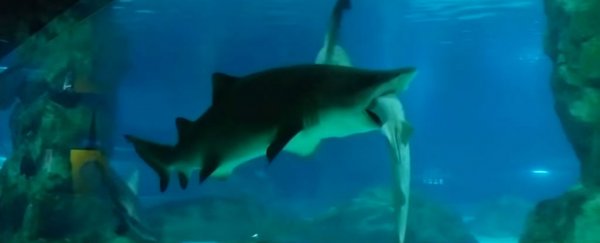
Nature is savage. If you're a wild animal, chances are you're going to die as a juvenile, and that's if you even make it past birth. If you're lucky enough to survive to adulthood, the odds of you making it to a ripe, old age are almost zero - you're almost definitely going to die of starvation, disease, or predation. So one of the benefits of living in captivity is these risks are cut right down… but not always, as this footage shot at the COEX aquarium in South Korea last week makes abundantly clear.
The aquarium's eight-year-old female sand tiger shark (2.2 metres long) reportedly chowed down on a smaller five-year old male shark, (1.2 metres long) in what the staff referred to as a "turf war". The attack happened on Thursday night, and after about 10 minutes of struggling, the female was seen cruising around the tank, slowly swallowing the body of her victim.
After 21 hours, the tip of the tail was still hanging out of the female's mouth, and thanks to her uncooperative digestive system, it might still be there now. "The aquarium said the tail is expected to stay in the shark's mouth for about four to five days. Unable to digest the creature, it will then will regurgitate it after about a week," Reuters reports.
The aquarium staff suspect that while their sharks all carve out a territory of their own within the confines of the tank, accidents can happen, and that's when instinct takes over.
"Sharks have their own territory. However, sometimes when they bump against each other, they bite out of astonishment," COEX aquarium PR manager, Oh Tae-youp, told Reuters. "I think the shark swallowed the whole body, because they usually eat it all when they bite the head part."
While some species certainly do better than others, sharks generally don't do that well in captivity. Earlier this month, a great white shark died in an aquarium in Japan after just three days, because it refused to eat any food after being captured.
Great whites are notoriously difficult to keep in captivity - the longest anyone's been able to do it is Monterey Bay Aquarium in California, which housed one that had been accidentally caught by a fishing boat for 198 days before releasing it back into the wild. It ended up attacking two other sharks and seriously injuring itself on the glass. The aquarium has since suspended its great white program indefinitely.
Smaller species can do better, but when they're not getting themselves into unwanted turf wars, they're consuming crazy-expensive amounts of food, getting confused about their suddenly non-existent migration patterns, and having to swim non-stop in a relatively small area to maintain body temperature and oxygen flow in the blood.
Basically, there's not a whole lot of reason for them to be in captivity, unless they're being rehabilitated from an injury sustained in the wild. We should just let them live free and grow huge out there in the ocean, just like this Australian champion.
